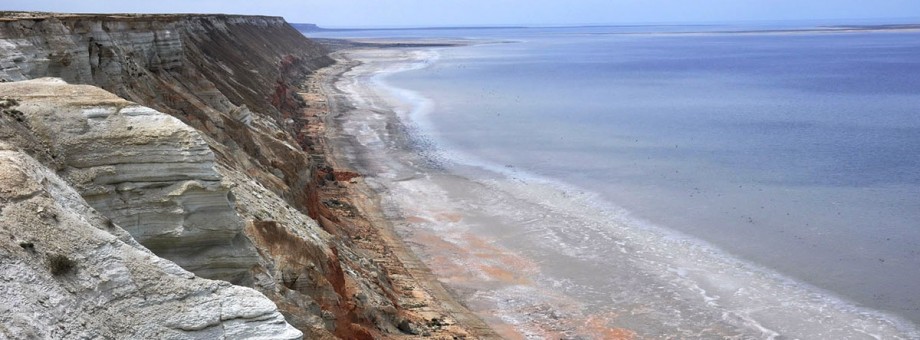Garabogazgol: Inexhaustible treasures of the bay

The Garabogazgol Bay is one of the most famous natural attractions of Turkmenistan and the biggest salt basin on the Earth. Its area is around 18 thousand square kilometres.
Many people know that Garabogazgol Bay is the saltiest place of Caspian Sea, however, only few knows that salinity of its water is totally of different kind rather than in in the sea. The bay is distinguished with high content of Glauber’s salt (mirabilite), due to which the water does not freeze even at -10 degrees Celsius.
Многие знают, что самое соленое место Каспийского моря – это залив Гарабогазгол, но немногие знают, что соленость его вод совершенно иного типа, чем морская. Залив отличает высокое содержание глауберовой соли (мирабилита), благодаря чему вода в нём не замерзает даже при температуре минус 10 градусов по Цельсию.
The bay is separated from the sea with northern and southern sandbars. It had the only sea river of the kind, which used to carry its waters across the desert to the bay. The difference of levels of the sea and bay is around four meters, therefore, waters of Caspian Sea has run to solid formation barrier with high speed and the river has fallen down with roar making clouds of white sea foam…
От моря залив отделяют северная и южная песчаные косы. Здесь существовала единственная в своем роде морская река, несущаяся воды через пустыню в залив. Разность уровней моря и залива составлял около 4 метров, поэтому вода Каспия устремлялась к твёрдому порогу с большой скоростью, река с ревом срывалась вниз, обрушивая клубы белой морской пены…
Duke Alexander Bekovich – Cherkasskiy was the first explorer who took a risk and entered the bay in 1715 on sail ships through the straight and made the first truthful geographic map of this part of the sea and bay by the order of Peter I.
The next expedition led by Russian hydrographer and cartographer F. I. Soymanov took place in 1726. However, the fear of seamen to be killed in the Black Maw did not allow them entering the bay. Bad reputation of the abyss that sinks the ship has intruded the implement the plans. It is not occasionally the Gara bogaz is translated as black maw from Turkmen language.
Finally, back in 1836, the expedition lead by G. S. Karelin had managed to enter the bay on boats. “Karabugaz Bay, - G. S. Karelin wrote, - might be called as a separate sea…”.
Expedition led by I. M. Zherebtsov has been organized in 1847. Same like G. S. Kerlin, Zherebtson was astonished with the view of the bay. According to his words, the bay “had deadly waters, which corroded even steel objects in a short time”. “Salt, sands and everything killing life reign over these unhospitable coast and waters of the bay. Caustic salt water of the bay blinded fish entering the bay and threw dead corpses to shore. For many years of wandering, I have not seen such dreary coast threatening seafarers…”
Soon, it has become obvious that Garabogazgol (or Karabogazgol as it was used to be called before) is a treasury of mineral salts having various properties and the bay received another name – Golden Bottom. Everybody in the world became aware of the treasury in the bay. It has gained reputation of unique stockpile of hydro mineralogical materials, which contained almost all elements of periodic table. Many scientists were engaged in study of resources of the bay in the beginning of XX century.
Industrial development of sodium sulphate has started in Garabogaz in 1924. The first chemical facility “Karabogazhim”, which was re-organized into “Karabogazsulphat” Factory in 1940, has been opened in 1929. Production of gypsum and delivery of product to the hospitals have been arranged in this place in the years of great Patriotic War.
In addition to sodium sulphate, industrial production of epsomite (magnesium sulphate), bischofite (magnesium chloride), medical Glauber’s salt, sea salt, table salt and other minerals used in various industrial branches has been started these years.
Production of more than dozens of chemicals has been arranged for 80 years based on the resources of the bay. Nevertheless, the scientists think that further integrated involvement of mineral material of Garabogazgol Bay will accelerate diversification of chemical industry and make a base for the formation of hydrometallurgy. It will allow reducing import of the range of production components and ready made production and significantly increasing export potential of the country.
Despite different opinions of specialists, the bay was closed dammed from the sea in 1980. It has become drying rapidly and after few years, has turned into huge salt desert, which caused worsening of ecology of Garabogaz region and emerging of salt storms. There was only one solution to open the dam. It was made in 1992 and seawater received free flow to the bay.
Modern production in Garabogaz is aimed at receiving of sodium sulphate, bischofite, epsomite, table salt, bromine – more than a dozen types of industrial production. However, scientist think that only part of the resources of the bay is used. Organization of many perspective and interrelated industrial productions, which production technology is well-known in the world practice, is possible based on available reserves of hydro mineralogical resources. This is about wide application of bischofite, which contains 64 elements of periodic table.
It was estimated that mineral reserves of the bay like sodium sulphate, bischofite, epsomite, magnesium of magnesium oxide extracted from brine are widely used in more than 25 various branches of the world industry starting from cosmetic, aircraft and automobile construction to crop growing and soap production. Therefore, integrated involvement of inexhaustible reserves of the bay into industrial production has a strategic importance for Turkmenistan.
Opening of new production facilities on the base of Garabogazsulphate Production Association will significantly extended the capabilities of chemical industry of the country and form up new perspective branches like non-ferrous metallurgy, hydrometallurgy and heavy engineering construction.


 HABARLAR
HABARLAR